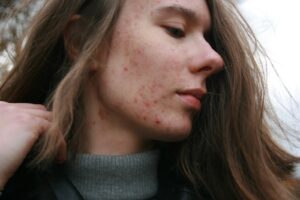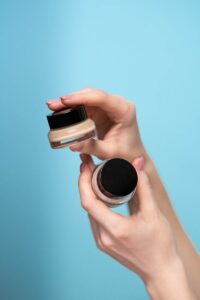How to Conceal Blemishes: Top Tips for Hiding Pimples and Acne
Experiencing breakouts can be challenging, both physically and emotionally. Whether you have acne-prone skin or just a stubborn pimple, knowing how to conceal blemishes effectively can make a world of difference in your daily confidence. This guide will explore the causes of acne, types of acne you may encounter, and the importance of maintaining healthy skin. Additionally, we’ll provide practical tips on using concealers and makeup to help you achieve a flawless complexion.
Understanding Acne and Pimples

Photo by Barbara Krysztofiak on Unsplash
Acne is a common skin condition that affects individuals of all ages, resulting in various types of blemishes. Breakouts often occur due to a combination of excess oil production, clogged pores, and inflammation. Factors such as hormonal changes, stress, and diet can also contribute to the formation of pimples. It’s essential to understand that not all blemishes are the same; each type of acne has its own causes and characteristics, which can impact how you choose to conceal them.
What Causes Breakouts?
Breakouts are often triggered by factors like hormonal fluctuations, which can cause the skin to produce excess sebum. This excess oil can lead to clogged pores, resulting in acne. Additionally, dead skin cells that accumulate on the surface can further inflame the skin, making it susceptible to various types of acne, including blackheads and whiteheads. Environmental factors, such as pollution, and lifestyle choices, like diet and stress levels, can also contribute to the development of pimples. Understanding these triggers can help you manage your skin better and choose the right products to conceal blemishes effectively.
Types of Acne: Pimples, Blackheads, and Whiteheads
Acne manifests in several forms, including pimples, blackheads, and whiteheads. Pimples are inflamed spots that can be painful and red, while blackheads are open comedones filled with oxidized oil, giving them a dark appearance. Whiteheads, on the other hand, are closed comedones that appear as small, white bumps on the skin. Each type of acne requires a different approach to treatment and concealment. For instance, using a full-coverage concealer can help cover a pimple effectively, while a color-correcting concealer may be ideal for reducing redness associated with inflamed blemishes.
The Importance of Healthy Skin
Healthy skin is essential not only for aesthetic purposes but also for overall well-being. Maintaining a proper skincare routine can help hydrate and nourish your skin, preventing future breakouts. It’s crucial to use non-comedogenic products, which won’t clog your pores, and to regularly exfoliate to remove dead skin cells. A well-prepped complexion makes applying makeup much easier and can prevent your foundation and concealer from appearing cakey. Moreover, consulting with a dermatologist can provide personalized acne treatment options, ensuring that you maintain a healthy skin barrier while hiding blemishes effectively.
Choosing the Right Concealer
Choosing the right concealer is crucial for effectively hiding blemishes and achieving a flawless complexion. The ideal concealer should not only help cover pimples and other types of acne but also match your skin tone perfectly. A well-chosen concealer can enhance your overall makeup look and boost your confidence. It’s essential to consider the specific skin issues you face, such as redness from breakouts or dark spots left by previous acne. By understanding your skin’s needs and the available concealer options, you can select a product that will seamlessly blend into your skin, providing the coverage you desire without making your skin look cakey.
Identifying Your Skin Tone
Identifying your skin tone is a vital step in selecting the right concealer. Skin tones typically range from fair to deep, and within these categories, there are undertones such as cool, warm, and neutral. To find your perfect shade, observe how your skin reacts to sun exposure—if you tan easily, you may have a warm undertone, while those who burn easily often have a cool undertone. Testing concealers in natural light can also help ensure that the shade matches your skin tone accurately. When you apply concealer, it should blend flawlessly with your complexion, allowing you to conceal blemishes, like zits and whiteheads, without any visible lines.
Types of Concealers for Different Skin Issues
There are various types of concealers designed to address different skin issues. For instance, a full-coverage concealer is ideal for concealing inflamed pimples and larger blemishes, as it provides a thicker consistency that effectively hides imperfections. On the other hand, lightweight concealers can hydrate the skin while offering sheer coverage for minor redness or fine lines. If you’re dealing with stubborn blackheads or acne-prone skin, a non-comedogenic formula is essential to prevent further breakouts. Makeup artists often recommend using a makeup sponge for application, as it can help achieve a seamless finish while ensuring that the concealer doesn’t settle into fine lines or dry patches.
Color-Correcting Concealers Explained
Color-correcting concealers are a fantastic option for tackling specific skin concerns such as redness from breakouts. These specialized concealers usually come in shades like green or peach, designed to counteract various skin discolorations. For example, a green concealer can neutralize the redness associated with inflamed acne, while a peach or orange-toned concealer can help conceal dark circles or hyperpigmentation. When using color-correcting concealer, it’s essential to apply a thin layer and blend it well before applying your full-coverage foundation or regular concealer. This technique ensures that the rest of your makeup adheres properly and that your complexion looks even and radiant, without any visible patches or cakey areas.
How to Apply Concealer for Maximum Effect
Preparing Your Skin Before Application
Before you apply concealer, it’s crucial to prep your skin adequately to achieve the best results. Start by cleansing your face to remove any impurities and excess oil that could enhance the visibility of your blemishes. Following cleansing, apply a lightweight moisturizer to hydrate your skin—this step is vital, especially for those with acne-prone skin, as it can help prevent the skin from becoming inflamed or too dry. A non-comedogenic moisturizer is ideal, as it won’t clog your pores. Lastly, consider using a primer tailored to your skin type; this will create a smooth canvas for your makeup, allowing the concealer to glide on seamlessly and ensuring your complexion appears flawless throughout the day.
Step-by-Step Guide to Applying Concealer
To effectively apply concealer, start by choosing a shade that matches your skin tone or is one shade lighter for a brightening effect. Using a clean makeup sponge or your fingertip, dab the concealer onto areas you want to conceal, such as pimples, redness, or dark spots. Gently tap the product into the skin rather than rubbing it, as this technique helps blend the concealer without inflaming the skin. For larger blemishes, a full-coverage concealer is recommended to ensure that the zit is well concealed. After applying, set your concealer with a light dusting of setting powder to prevent it from settling into fine lines or looking cakey. This step will help your makeup last longer and maintain a polished appearance.
Using Makeup to Enhance Your Complexion
After successfully applying your concealer, the next step is to use makeup to enhance your overall complexion. A full-coverage foundation can provide a smooth, even base while further concealing any remaining blemishes. When choosing foundation, look for a formula that matches your skin tone and is suitable for your skin type, whether oily, dry, or combination. Additionally, incorporating a color-correcting concealer before foundation can help neutralize any redness or discoloration, allowing the rest of your makeup to adhere better. Finally, finish your look with a setting spray or powder to lock everything in place, ensuring your makeup stays fresh and vibrant throughout the day without making your skin look overly heavy or cakey.
Setting Your Makeup for Longevity

Photo by Kelly Sikkema on Unsplash
The Role of Setting Powder
Setting powder plays a crucial role in ensuring that your makeup remains intact throughout the day, especially when dealing with blemishes or acne-prone skin. After applying your concealer and foundation, a light dusting of setting powder can help absorb excess oil, preventing your makeup from sliding off or looking cakey. Furthermore, it minimizes the appearance of fine lines and helps to reduce any redness from breakouts, allowing your complexion to appear smooth and polished. For best results, use a makeup sponge or a soft brush to apply the powder evenly, focusing on areas where you tend to experience shine, such as the T-zone.
Best Practices for Wearing Concealer
When it comes to wearing concealer, there are several best practices to enhance its effectiveness and longevity. First, always prep your skin by moisturizing and applying a primer tailored to your skin type, which helps create a smooth base for your makeup. After applying concealer to your blemishes, consider using a lightweight, full-coverage foundation to achieve a flawless finish. It’s important to use a makeup sponge for blending; this technique helps to prevent the concealer from settling into fine lines or inflaming the skin. Finally, setting your concealer with powder can ensure that it stays in place, preventing any unwanted touch-ups throughout the day.
Recommended Makeup Products
Choosing the right makeup products is essential to effectively conceal blemishes and achieve a flawless look. Look for non-comedogenic concealers that won’t clog your pores, particularly if you have acne-prone skin. A full-coverage concealer can help cover stubborn pimples and conceal blemishes, while color-correcting concealers can neutralize redness or dark spots. Additionally, a quality setting powder will lock your makeup in place, giving you that fresh appearance for longer. Brands that specialize in acne treatment often offer formulations specifically designed to conceal blemishes without making your skin worse, ensuring you can confidently wear makeup without compromising your skincare.
Tips for Managing Breakouts

Photo by RDNE Stock project on Pexels
Hydrating Your Skin
Hydrating your skin is crucial for managing breakouts effectively. Although it may seem counterintuitive to apply moisture to acne-prone skin, hydration can help balance oil production and prevent the skin from becoming overly dry, which can lead to inflammation and more breakouts. Opt for lightweight, non-comedogenic moisturizers that provide hydration without clogging pores. Ingredients like hyaluronic acid and glycerin can offer hydration while keeping your skin’s barrier intact. Remember, well-hydrated skin not only looks healthier but also creates a better canvas for applying concealer and foundation, allowing your makeup to adhere properly and minimizing the risk of a cakey appearance.
Preventive Measures Against Future Acne
To prevent future acne breakouts, it’s important to adopt a proactive skincare routine. Incorporate gentle exfoliation to remove dead skin cells, which can clog pores and lead to pimples. Additionally, consider using products that contain salicylic acid or benzoyl peroxide to target existing blemishes and prevent new ones from forming. Maintaining a balanced diet rich in fruits, vegetables, and adequate hydration can also contribute to clearer skin. Always be cautious with makeup products; choose those labeled as non-comedogenic to ensure they won’t exacerbate your skin issues. Remember, the goal is to keep your complexion healthy while effectively concealing any breakouts when they occur.
When to Seek Professional Help
If your acne persists despite following a consistent skincare routine, it may be time to seek professional help. Consulting with a dermatologist can provide you with personalized acne treatment options tailored to your skin’s unique needs. They can recommend effective topical treatments, oral medications, or advanced procedures to help manage your breakouts. Additionally, if you find that your acne is leading to emotional distress or self-esteem issues, a professional can offer support and guidance. Understanding when to turn to a dermatologist is key in your journey towards achieving a clear complexion and managing the impact of blemishes on your daily life.
Frequently Asked Questions (FAQs)
What is the purpose of using a concealer?
A concealer serves to hide imperfections on your skin, such as blemishes, acne, and redness. It’s a fantastic tool that allows you to achieve a flawless look. By applying it strategically, you can effectively conceal blemishes that you wish to downplay, enhancing your overall skin tone and boosting your confidence!
How do I choose the right concealer for my skin tone?
Choosing the right concealer is crucial for achieving that natural look. You want a shade that matches your skin tone closely. Test a few shades on your jawline and opt for one that blends seamlessly into your skin. Remember, you can also use a color-correcting concealer for specific issues like redness or dark circles!
Can concealers help conceal blemishes and pimples?
Absolutely! A good full-coverage concealer can help you conceal blemishes effectively. Look for non-comedogenic formulas that won’t clog your pores or make your acne worse. When you apply concealer, dab it lightly on the pimple or blemish using a makeup sponge for a smooth finish.
What is the best technique to apply concealer?
To get the best results, first, prep your skin with a good skincare routine. Use your finger or a makeup sponge to gently tap the concealer onto the area you want to cover. Start with a small amount and build up if necessary, ensuring it doesn’t appear cakey or settle into fine lines. Choose a concealer that is a shade lighter than your foundation for brightening areas like under the eyes, or a shade that matches your foundation to conceal blemishes and redness.
When applying concealer under your eyes, use a light hand and a tapping motion to blend it seamlessly into your skin. Consider using a damp makeup sponge or a fluffy brush to help diffuse the product for a more natural finish. Additionally, try to apply the concealer in a triangular shape, extending it slightly towards your temples; this technique can help lift and brighten the eye area.
To conceal blemishes or imperfections on other parts of your face, use a small, precise brush to apply the concealer directly onto the spot, then blend the edges with your fingertip or sponge to ensure it melds with your foundation without disturbing the surrounding makeup.
Finally, set your concealer with a light dusting of translucent powder to prevent creasing and ensure longevity throughout the day. Remember, less is often more when it comes to concealer, so take your time to layer it gradually for the best results.



